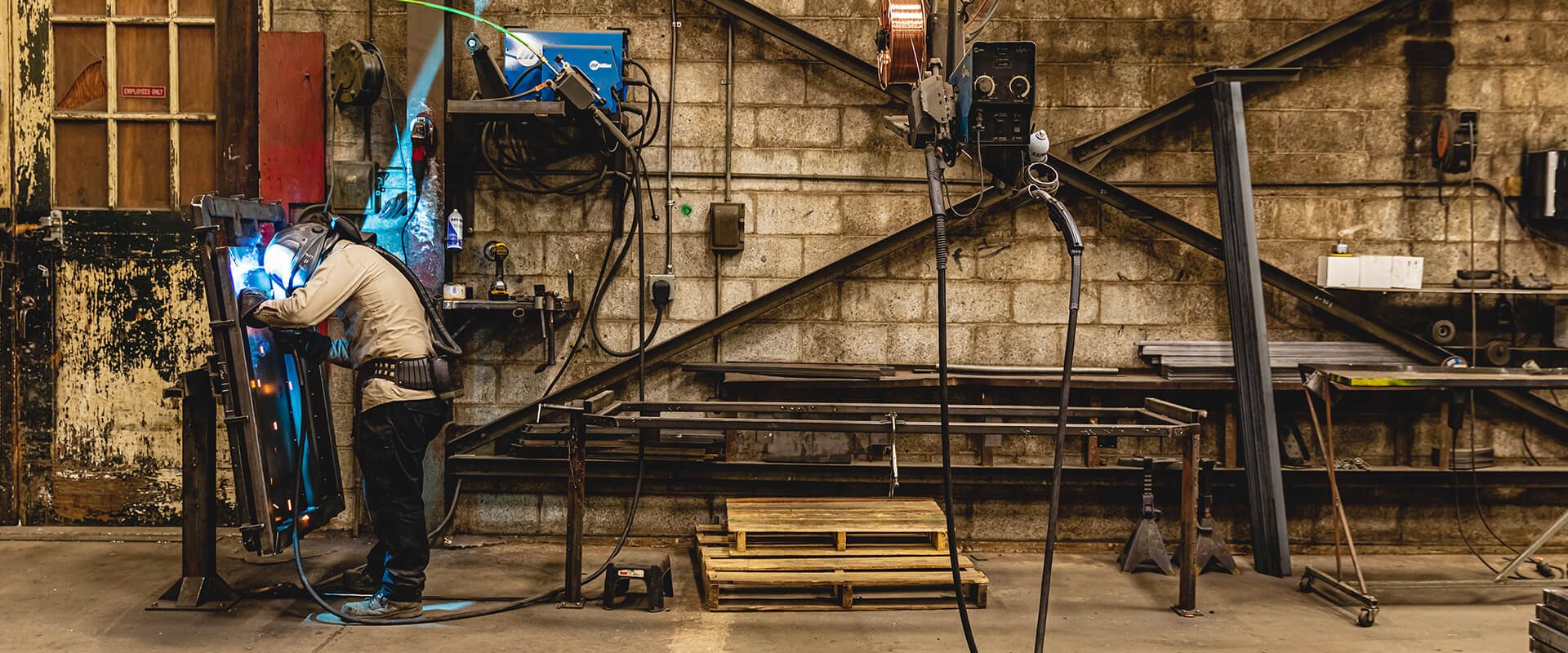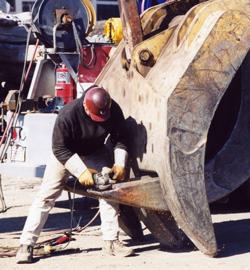Everything about Welding: Secret Insights Into Techniques and Ideal Practices for Success
Welding encompasses a selection of techniques, each fit for details materials and applications. Understanding these approaches, such as GMAW, SMAW, and TIG, is essential for accomplishing optimal outcomes. The best devices and safety and security practices can not be neglected. As preparation and fixing play important duties in the welding process, grasping these aspects can significantly improve the high quality of the end product. What are the essential factors that ensure a successful weld?
Comprehending Various Welding Strategies
Welding strategies incorporate a variety of methods, each suited to particular applications and materials. Among the most common methods are Gas Metal Arc Welding (GMAW), Shielded Metal Arc Welding (SMAW), and Tungsten Inert Gas Welding (TIG) GMAW, also known as MIG welding, is popular for its speed and adaptability, making it ideal for thin materials. SMAW, or stick welding, is favored for its simplicity and performance in outside settings, especially with thicker steels. TIG welding uses precision and control, making it ideal for detailed work and non-ferrous metals (Belgrade). Each strategy has its special benefits and factors to consider, permitting welders to pick the finest technique based upon the project's needs, material type, and wanted outcomes. Recognizing these strategies is vital for successful welding
Necessary Welding Tools and Tools
While numerous welding methods require certain skills, the ideal devices and tools are similarly vital for achieving high quality results. Important welding tools consists of welding devices, which vary depending upon the strategy-- such as MIG, TIG, or stick welding. Safety gear, consisting of handwear covers, aprons, and safety helmets, guarantees safety and security and comfort during the process. On top of that, clamps and fixtures help safeguard materials in place, making sure precision in welds. Consumables like welding rods, wire, and shielding gas are also essential elements that influence the quality of the weld. In addition, devices such as cutters and grinders facilitate surface area preparation and post-weld ending up, contributing to a specialist outcome. Purchasing top notch equipment inevitably improves the performance and effectiveness of welding jobs.
Security Practices in Welding
Correct safety and security techniques are essential in the welding market to protect employees from potential hazards. Welders should use proper personal protective tools (PPE), including headgears with appropriate shading, handwear covers, and flame-resistant apparel. Appropriate ventilation is vital to minimize direct exposure to dangerous fumes and gases produced throughout the welding process. Furthermore, workers must be learnt the correct handling of welding equipment to avoid crashes. Fire precaution, such as maintaining flammable products away from the welding location and having fire extinguishers readily offered, are essential. Regular examinations of tools and offices can aid identify potential dangers before they cause mishaps. By adhering to these security methods, welders can create a safer working atmosphere and reduce threats connected with their trade.
Preparing Materials for Welding
Preparing products for welding is an important step that significantly influences the top quality and honesty of the final item (Belgrade Fabrication). Proper prep work involves cleansing the surfaces to get rid of impurities such as corrosion, dust, and oil, which can compromise the weld. Methods such as grinding, sanding, or making use of solvents are typically employed to accomplish a tidy surface area. Additionally, ensuring that the materials mesh comfortably is vital; spaces can bring about weak welds. It's likewise crucial to take right into account the placement and positioning of the parts, as this will certainly influence the ease of welding and the final result. Picking the ideal filler material and guaranteeing compatibility with the base steels is essential for achieving strong, long lasting welds.
Tips for Getting High-Quality Welds
Achieving high-grade welds requires focus to information and adherence to best techniques throughout the welding procedure. Appropriate joint preparation is vital, making sure surface areas are clean and cost-free from pollutants. Selecting the proper filler product and welding strategy based on the base steels is essential for suitable bonding. Preserving consistent traveling speed and angle while welding can promote and protect against flaws uniformity. In addition, managing warm input is important; excessive warm can lead to bending and compromised joints. If needed, frequently inspecting the welds during the procedure enables for prompt adjustments. Lastly, utilizing proper post-weld therapies, such as cleansing and stress and anxiety relief, can improve the longevity and integrity of the weld, ultimately making certain an effective outcome.
Fixing Typical Welding Issues
Welding frequently offers obstacles that can affect the high quality and stability of the final product. Typical issues such as porosity, inconsistent weld grains, and overheating can arise, each requiring details fixing methods. Recognizing these issues is crucial for welders to enhance their abilities and attain excellent outcomes.
Porosity Issues Described
Although porosity can typically be ignored, it stays a crucial issue in welding that can endanger the integrity of a completed item. Porosity describes the presence of little gas pockets within the weld grain, which can lead and compromise the joint to early failing. This problem normally arises from contaminants, dampness, or inappropriate shielding gas protection during the welding process. To mitigate porosity, welders should validate that the base materials are clean and completely dry, use appropriate shielding gases, and preserve constant welding specifications. On a regular basis examining the tools and atmosphere can additionally help recognize potential issues before they show up in the weld. Resolving porosity properly is important for attaining solid, long lasting welds that meet top quality criteria.

Irregular Weld Beads
Inconsistent weld grains can significantly influence the high quality and stamina of a completed product. Numerous aspects add to this problem, consisting of improper travel rate, inaccurate amperage settings, and inconsistent electrode angles. When the welder moves also promptly, a grain might appear narrow and do not have penetration, while moving also gradually can trigger extreme build-up. Additionally, using the incorrect amperage can result in either undercutting or too much spatter, both of which concession weld stability. The welder's method, such as irregular lantern movement, can likewise result in irregular grain look. To mitigate these issues, welders must focus on maintaining constant, regulated movements and ensuring proper devices setups to attain uniformity in their welds. Uniformity is essential to accomplishing solid and trustworthy welds.
Getting Too Hot and Bending Issues
Too much warmth during the welding procedure can bring about substantial getting too hot and warping problems, affecting the architectural integrity of the work surface. These troubles frequently manifest as distortion, which can compromise alignment and fit-up, making more setting up challenging. Elements adding to overheating consist of the choice of welding parameters, such as voltage and travel speed, along with the kind of material being welded. To mitigate these concerns, welders need to preserve constant traveling speed and appropriate read more heat input while keeping an eye on the work surface temperature level. In addition, pre-heating or post-weld warmth treatment can aid ease tensions brought on by fast cooling - Belgrade Fabrication. Routine assessment and adherence to best techniques are essential in protecting against overheating and ensuring the longevity and reliability of bonded frameworks
Frequently Asked Concerns
What Are the Profession Opportunities in the Welding Sector?
The welding market offers varied job possibilities, consisting of positions as welders, designers, assessors, and educators. Specialists can operate in production, construction, aerospace, and automotive sectors, taking advantage of strong need and competitive incomes in numerous functions.
How Can I Enhance My Welding Rate Without Compromising High Quality?
To boost welding rate without sacrificing quality, one need to practice reliable methods, preserve equipment, optimize settings, and improve hand-eye coordination. Normal training and looking for responses can likewise greatly add to achieving much faster, high-quality welds.
What Qualifications Are Offered for Welders?
Countless qualifications exist for welders, consisting of those from the American Welding Culture (AWS), the National Center for Construction Education and Study (NCCER), and numerous industry-specific companies. These qualifications enhance employability and show ability proficiency.
Exactly How Does Welding Impact the Features of Metals?
Welding influences the residential or commercial properties of metals by changing their microstructure, which can cause adjustments in ductility, toughness, and firmness. Heat input and cooling rates throughout the process greatly affect these product attributes.
Can I Weld Dissimilar Metals With Each Other?
